OCZ Vector 150 (120GB & 240GB) Review
by Kristian Vättö on November 7, 2013 9:00 AM EST- Posted in
- Storage
- SSDs
- OCZ
- Indilinx
- Vector 150
Performance Consistency
In our Intel SSD DC S3700 review Anand introduced a new method of characterizing performance: looking at the latency of individual operations over time. The S3700 promised a level of performance consistency that was unmatched in the industry, and as a result needed some additional testing to show that. The reason we don't have consistent IO latency with SSDs is because inevitably all controllers have to do some amount of defragmentation or garbage collection in order to continue operating at high speeds. When and how an SSD decides to run its defrag and cleanup routines directly impacts the user experience. Frequent (borderline aggressive) cleanup generally results in more stable performance, while delaying that can result in higher peak performance at the expense of much lower worst-case performance. The graphs below tell us a lot about the architecture of these SSDs and how they handle internal defragmentation.
To generate the data below we take a freshly secure erased SSD and fill it with sequential data. This ensures that all user accessible LBAs have data associated with them. Next we kick off a 4KB random write workload across all LBAs at a queue depth of 32 using incompressible data. We run the test for just over half an hour, nowhere near what we run our steady state tests for but enough to give a good look at drive behavior once all spare area fills up.
We record instantaneous IOPS every second for the duration of the test and then plot IOPS vs. time and generate the scatter plots below. Each set of graphs features the same scale. The first two sets use a log scale for easy comparison, while the last set of graphs uses a linear scale that tops out at 40K IOPS for better visualization of differences between drives.
The high level testing methodology remains unchanged from our S3700 review. Unlike in previous reviews however, we vary the percentage of the drive that gets filled/tested depending on the amount of spare area we're trying to simulate. The buttons are labeled with the advertised user capacity had the SSD vendor decided to use that specific amount of spare area. If you want to replicate this on your own all you need to do is create a partition smaller than the total capacity of the drive and leave the remaining space unused to simulate a larger amount of spare area. The partitioning step isn't absolutely necessary in every case but it's an easy way to make sure you never exceed your allocated spare area. It's a good idea to do this from the start (e.g. secure erase, partition, then install Windows), but if you are working backwards you can always create the spare area partition, format it to TRIM it, then delete the partition. Finally, this method of creating spare area works on the drives we've tested here but not all controllers are guaranteed to behave the same way.
The first set of graphs shows the performance data over the entire 2000 second test period. In these charts you'll notice an early period of very high performance followed by a sharp dropoff. What you're seeing in that case is the drive allocating new blocks from its spare area, then eventually using up all free blocks and having to perform a read-modify-write for all subsequent writes (write amplification goes up, performance goes down).
The second set of graphs zooms in to the beginning of steady state operation for the drive (t=1400s). The third set also looks at the beginning of steady state operation but on a linear performance scale. Click the buttons below each graph to switch source data.
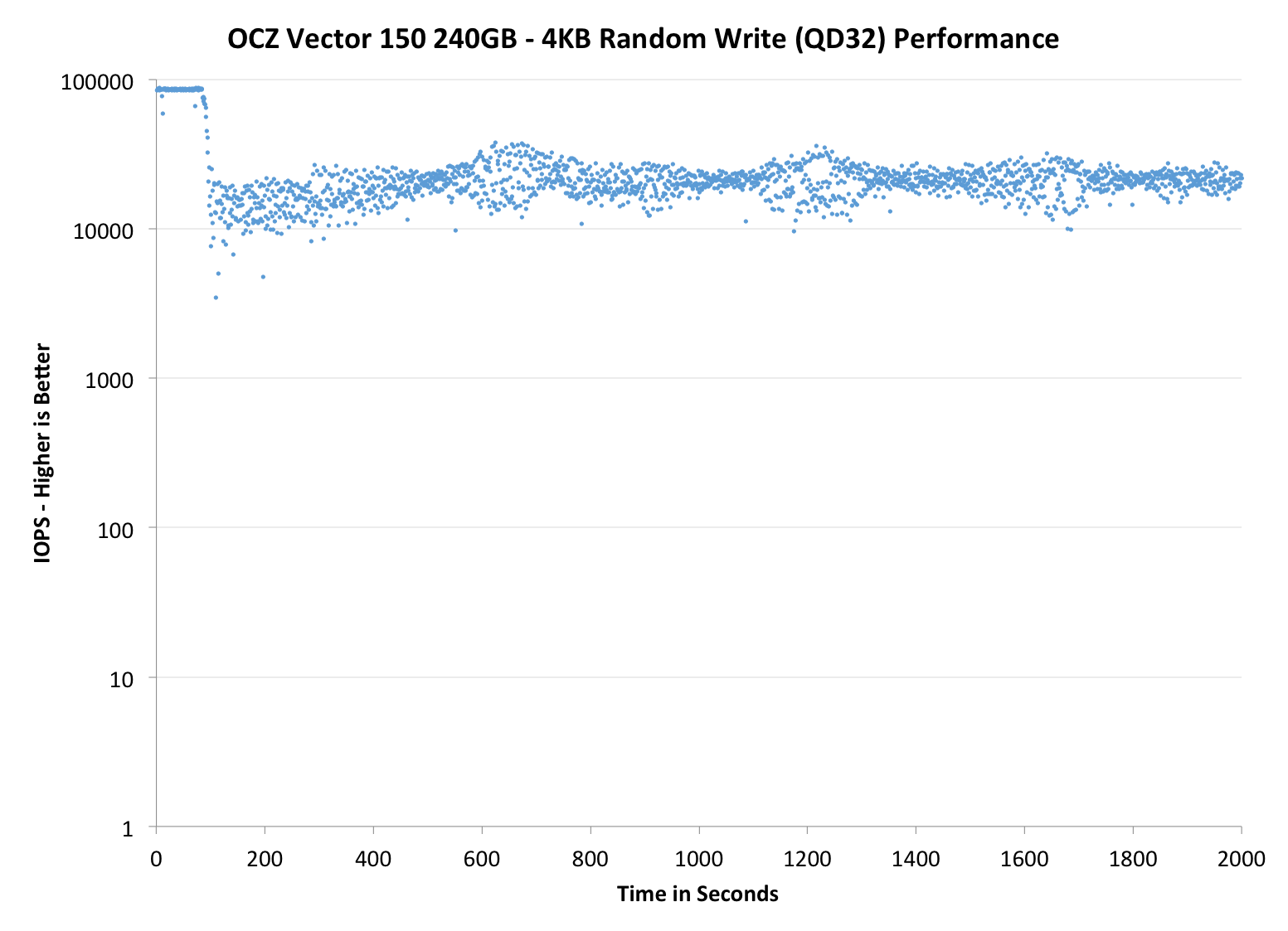 |
|||||||||
| OCZ Vector 150 240GB | OCZ Vector 256GB | Corsair Neutron 240GB | Sandisk Extreme II 480GB | Samsung SSD 840 Pro 256GB | |||||
| Default | |||||||||
| 25% OP | |||||||||
Performance consistency is simply outstanding. OCZ told us that they focused heavily on IO consistency in the Vector 150 and the results speak for themselves. Obviously the added over-provisioning helps but if you compare it to the Corsair Neutron with the same ~12% over-provisioning, the Vector 150 wins. The Neutron and other LAMD based SSDs have been one of the most consistent SSDs to date, so the Vector 150 beating the Neutron is certainly an honorable milestone for OCZ. However if you increase the over-provisioning to 25%, the Vector 150's advantage doesn't scale. In fact, the original Vector is slightly more consistent with 25% over-provisioning than the Vector 150 but both are definitely among the most consistent.
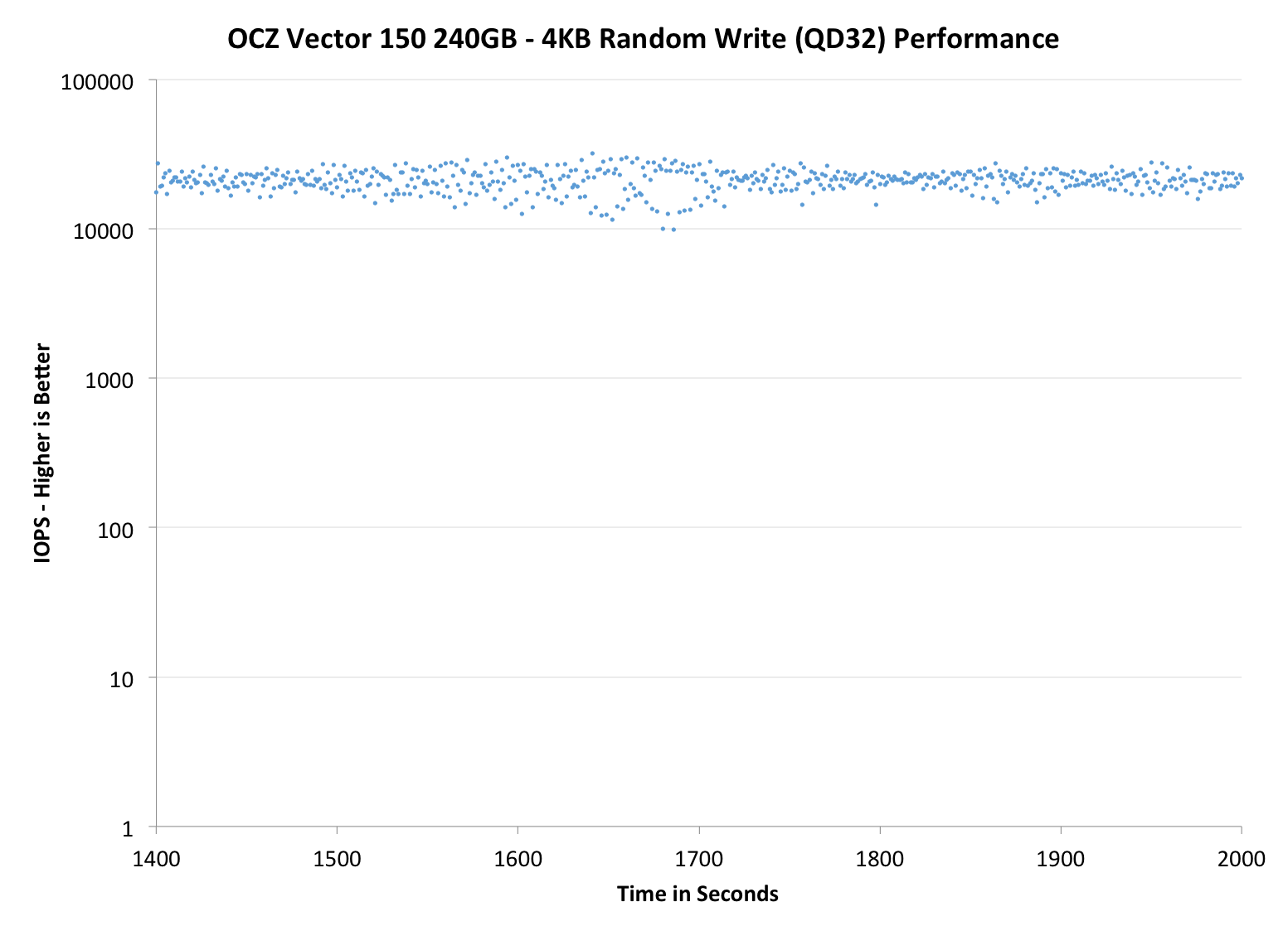 |
|||||||||
| OCZ Vector 150 240GB | OCZ Vector 256GB | Corsair Neutron 240GB | SanDisk Extreme II 480GB | Samsung SSD 840 Pro 256GB | |||||
| Default | |||||||||
| 25% OP | |||||||||
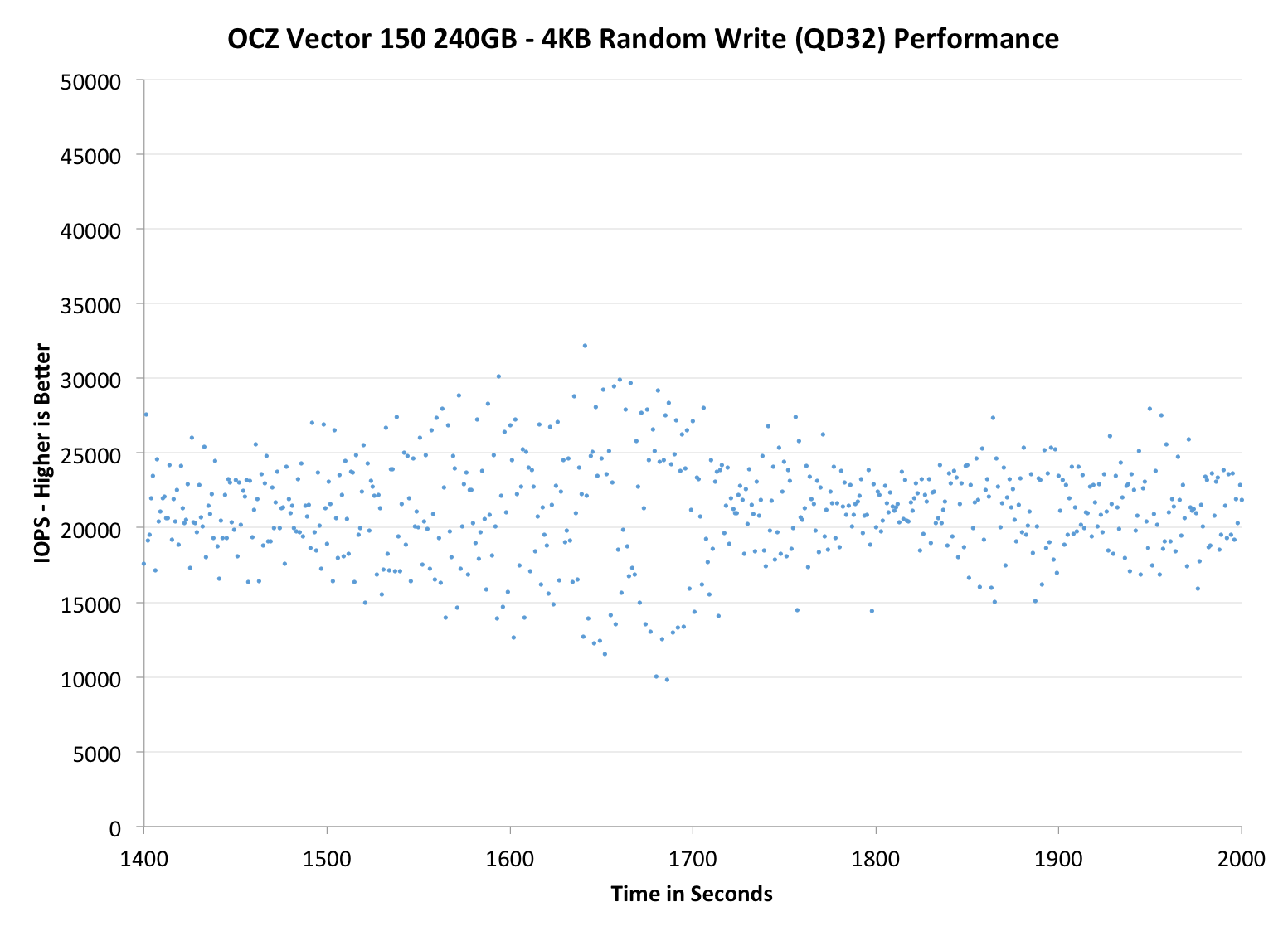 |
|||||||||
| OCZ Vector 150 240GB | OCZ Vector 256GB | Corsair Neutron 240GB | SanDisk Extreme II 480GB | Samsung SSD 840 Pro 256GB | |||||
| Default | |||||||||
| 25% OP | |||||||||
TRIM Validation
Above is an HD Tach graph I ran on a secure erased drive to get the baseline performance. The graph below is from a run that I ran after our performance consistency test (first filled with sequential data and then hammered with 4KB random writes at queue depth of 32 for 2000 seconds):
And as always, performance degrades, although the Vector 150 does pretty good with recovering the performance if you write sequential data to the drive. Finally I TRIM'ed the entire volume and reran HD Tach to make sure TRIM is functional.
It is. You can also see the impact of OCZ's "performance mode" in the graphs. Once 50% of the LBAs have been filled, the drive will reorganize the data, which causes the performance degradation. If you leave the drive idling after filling over half of it, the performance will return close to brand new state within minutes. Our internal tests with the original Vector have shown that the data reorganization takes less than 10 minutes, so it's nothing to be concerned about. The HD Tach graphs give a much worse picture of the situation than it really is.



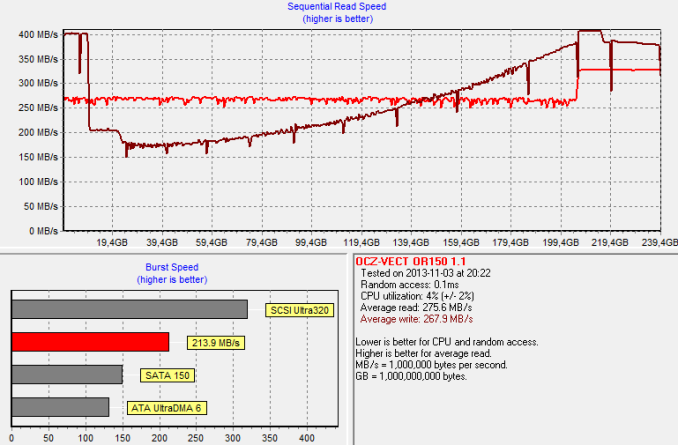
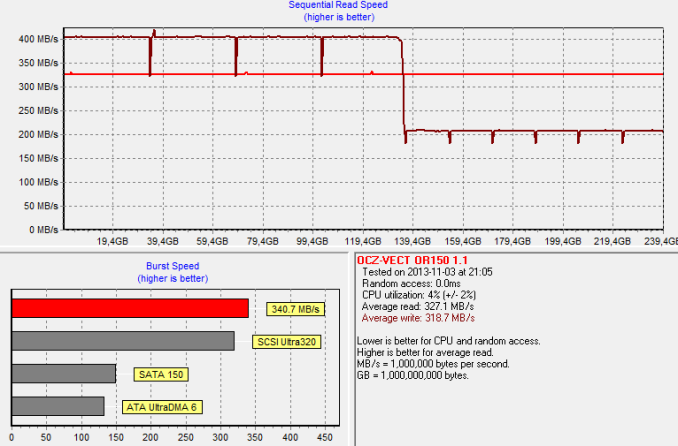








59 Comments
View All Comments
ssdpro - Thursday, November 7, 2013 - link
I really don't see how comparing a SSD purchase to suicide is relevant. Any component can fail at any time - it is not the end of life having a graphics card fizzle or SSD disappear. If anyone remembers when Anandtech reviewed the 840 Pro the sample died and then when they tested the replacement it died. It happens. http://www.anandtech.com/show/6328/samsung-ssd-840... I still buy and will buy Samsung, I have bought and will buy from OCZ.JellyRoll - Thursday, November 7, 2013 - link
Good luck with that.evonitzer - Friday, November 8, 2013 - link
As long as we're playing the anecdotal game, I bought a Vertex 2 and it failed, but allowed me to recover all the data from it. It was a little weird, but whatever. Reinstalled to it and it worked fine. Then I switched to a Vertex 4 and it has treated me well. So ...Samus - Friday, November 8, 2013 - link
I just don't get why people would consider an OCZ drive over the competition. It'd be like buying a Quantum Bigfoot, IBM Deskstar 75GXP or Conner S35-series drive, all of which either had storage, performance or price crowns of their time, but all well-known for their poor reliability, including their successors. All of these companies failed.Quantum was purchased by Maxtor who discontinued the Bigfoot, IBM was purchased by Hitachi (who struggled to get those GMR heads to work beyond the 60GXP) and Conner went bankrupt and the assets were ironically purchased by Quantum who liquidated everything but their tape-backup business.
TheWrongChristian - Friday, November 8, 2013 - link
The difference is that the Samsung samples were promptly fixed with a firmware update before it was released to retail. I'd have no faith in OCZ fixing such firmware issues, and the Samsung 840 Pro has gone on to be a solid dependable drive.These failures are almost always firmware bugs, I think SSD generally rarely physically fail (though I have no numbers to back that up) and OCZ don't have a stellar reputation in that department.
Not that OCZ will be around to honour the 5 year warranty anyway....
djscrew - Saturday, November 9, 2013 - link
i do have to agree, my revodrive takes forever to boot... gonna have to try that space thingweiran - Thursday, November 7, 2013 - link
Interesting SSD but at this price I think I'd rather have the Sandisk Extreme II.JellyRoll - Thursday, November 7, 2013 - link
Yes I agree. Sandisk had been around 25 years. Ocz will be lucky to be around for another three months, thier cash burn is ridiculous and they are running on fumes provided by loan sharks....which is why they are a penny stock, yet no one buys them. The reason they haven't been bought is that the barefoot is just a rebadged marvell controller.they have no ip.chubbypanda - Thursday, November 7, 2013 - link
SanDisk? Since 1988, but for how many years are in SSD business (very, very short time).JellyRoll - Friday, November 8, 2013 - link
Yes, but they have produced NAND since its introduction 25 years ago. That is experience, and longevity.